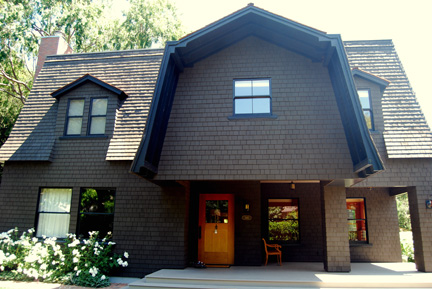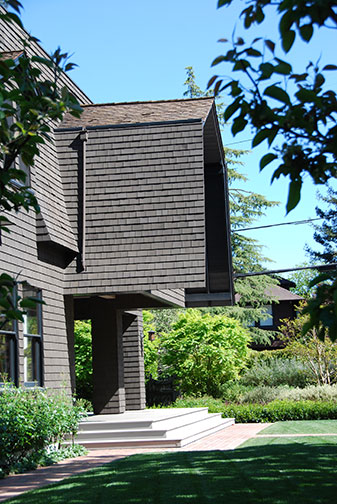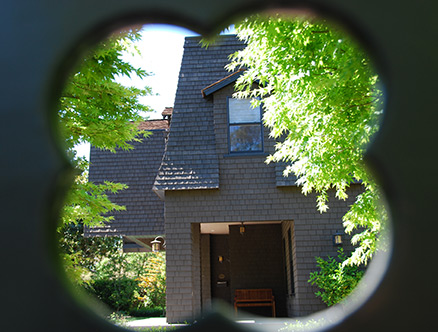 Palo Alto Stanford Heritage
Palo Alto Stanford Heritage 
1061 Bryant Street was built in 1899 for Emma Kellogg by Bernard Maybeck. It is the only structure ever built by this noted architect in Palo Alto and one of the few located south of San Francisco. It is listed as a Category 2 house on Palo Alto’s Historic Inventory.
Throughout the first half of the 20th century, many professional architects made their imprint on Northern California. Bernard Maybeck was one of several well–educated eastern architects to arrive in San Francisco in the 1890s. By 1894, he established a private practice in Berkeley and began teaching at the University of California in Berkeley. Describing himself as “a long distance dreamer,” he produced work in the Mission style, Gothic revival, Arts and Crafts and Beaux–Arts Classicism. His designs were as varied as San Francisco’s Swedenborgian Church, the Palace of Fine Arts and the auto dealership on Van Ness. At the center of the Craftsman movement in the Bay Area, he mentored many young architects, including Julia Morgan. Drawing on a wide variety of stylistic and regional inspiration, Maybeck’s work is characterized by functional design, the use of shingles and stained wood and a close relationship between indoors and out. His clients were cultural leaders and professors. This house in the Professorville Historic District of Palo Alto is typical of his innovative work.

Maybeck had already built a house for Emma Kellogg in 1896 at 1061 Bryant but it was destroyed by fire in 1898. His second house for her is a bold, asymmetrical composition with a recessed entry porch open to the south and the west. A low flight of broad corner steps leads to the intersecting streets bounding the site. A cantilevered portion of the second story, once supported by large console brackets, shelters the entrance, and the entire building is dominated by a large gambrel roof. It is from this cantilevered porch roof that 1061 Bryant derives its familiar name, the Sunbonnet House. A second floor, front room juts out and its roofline, in descending towards the porch, gives the impression of a sunbonnet hat.

Emma Kellogg lived in the Sunbonnet House until 1950 where she was an activist for the hearing impaired. Her interest in this issue was rooted in the very personal as she herself was deaf. She founded the Hard of Hearing Club on Dec. 4, 1929. It was dedicated to bettering the life of the hearing impaired through provision of hearing aids, teaching lip reading and sponsoring social functions. Magazines and scientific books were donated to Stanford and local libraries in order to bring public awareness to this issue. By 1937, 165 clubs, based on Kellogg’s model, had been founded. Emma Kellogg was named Honorary President of the Club for the rest of her life. From 1950–1970, the Judy family lived at 1061 Bryant. James Judy is known for convincing the City Council that stop signs at alternating cross streets were a safer alternative than arterials and one–way streets. The current occupants bought 1061 Bryant Street in 2003 and undertook a painstaking museum quality restoration. After removing 40 years worth of ill–conceived renovations, they succeeded in recreating much of Maybeck’s original design. ©
PAST, September 28, 2012
| |
E-mail us at either webmaster@pastheritage.org or president@pastheritage.org.
![]() Palo Alto Stanford Heritage—Dedicated to the preservation of Palo Alto's historic buildings.
Palo Alto Stanford Heritage—Dedicated to the preservation of Palo Alto's historic buildings.
Copyright © 2015 Palo Alto Stanford Heritage. All rights reserved.